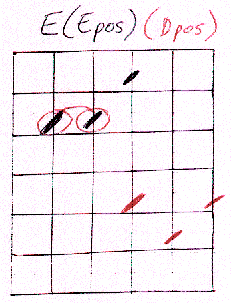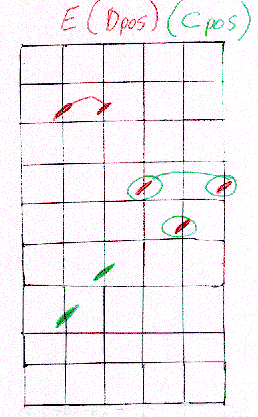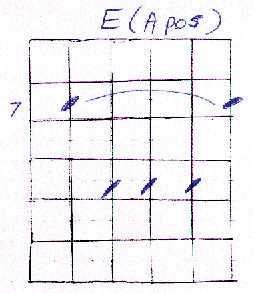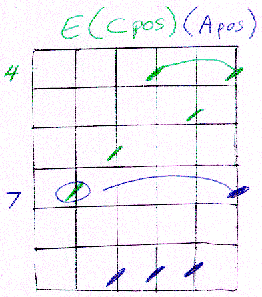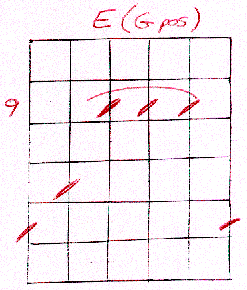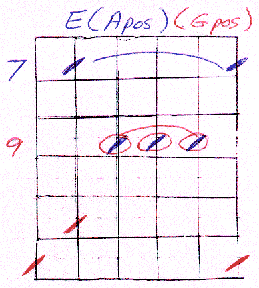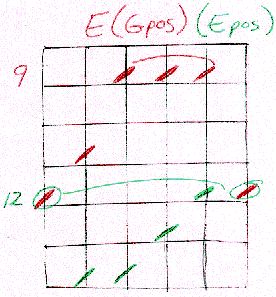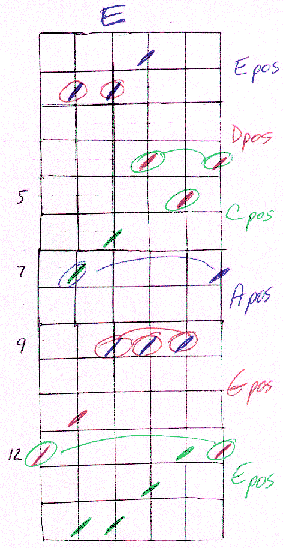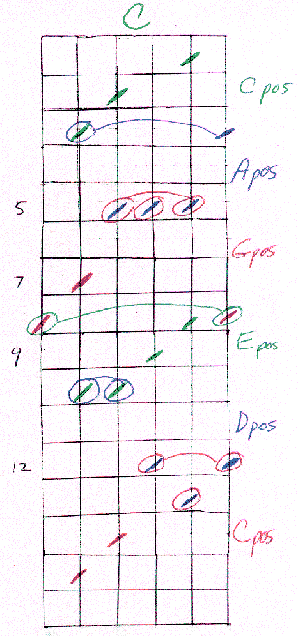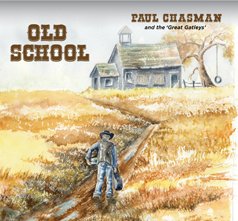CAGED - February 15, 1999
 Today
I would like to offer you a map of the neck. This is a system which
has evolved over thirty years of teaching. The purpose is to give
you a network of chord shapes in which you can be anywhere on the
neck and have a chordal frame of reference at that point. Beyond
that, this map can give you a clear picture of the connection and
interrelationship of all the chord forms. Today
I would like to offer you a map of the neck. This is a system which
has evolved over thirty years of teaching. The purpose is to give
you a network of chord shapes in which you can be anywhere on the
neck and have a chordal frame of reference at that point. Beyond
that, this map can give you a clear picture of the connection and
interrelationship of all the chord forms.
The simple basis of this system is that everything on the guitar is chromatically moveable. If you play an F chord and move it up a half step, you get an F#. If you understand this concept, read on. Let's cover the neck with E chords. Your goal will be to close your eyes, point to a spot on the neck, and find an E chord right there. So, we begin with E:
That was easy enough. Now, if you play an open D chord, refinger it with your 2nd, 3rd, and 4th fingers, slide it up a half step, and barre the 1st fret, you will have D#. If you come up another half step, you will have E. I will call this E in a D position, or E (D pos):
Very important: Look at how E (D pos) intersects with E (E pos). The barre in the E (D pos) intersects the E (E pos) at the 2nd fret.
Now play a C chord, refinger with your 2nd, 3rd, and 4th fingers, bring it up a half step and barre the 1st fret (I normally only barre the first three strings). You now have C#. Keep moving up in half steps until your barre is in the 4th fret. You now have E (C pos).
If you use the same procedure with A position, you will wind up barring at the 7th fret for E (A pos).
The barre in the A position is placed at the same fret as our root in the bass in the C position.
The G position is next. Remember that in an open G chord, the chord shape is on the 2nd and 3rd frets. Therefore, your barred G position must be in the 2nd and 3rd frets above the barre.
And E (G pos) intersects E (A pos) like this:
Your E (G pos) should end up at the 12th fret. Because the 12th fret is the octave, you have now come full circle. If you have a cutaway, you can barre at the 12th fret and play an E position, which is where we started.
What you can see is that we have a system of 5 chord positions, each one starting where the last one left off. We can now cover the neck with E chords, with no gap between positions:
If you are shaky on the ground we have covered so far, I would recommend stopping here and solidifying the above steps. If you are still with me, let's keep going. The order of interlocking positions I have laid out for you will work in any key. The only thing that changes is the starting point. For example, if we want to cover the neck with C chords, the order will look like this:
If you look at the order of positions in key of C, the order goes: C-A-G-E-D, which spells CAGED. This will always be the order, and the positions will always connect at the same points. Always start from whatever position you are on, and spell CAGED. When we were in key of E, we went: EDCAG. If we are in key of A, we will go: AGEDC. If you want to cover the neck with Bb chords, start on Bb (A pos), barred at the 1st fret, and go AGEDC. Now you have a system by which you can play any major chord and cover the neck with that chord, using 5 interlocking positions. Remember: these chord shapes are a frame of reference for anything you can do on the guitar. Anything you know how to do with an A chord, you know how to do in E (A pos). It is possible to alter these chord forms to make minors, 7ths or any other form you want. If you can play Am, you can play Em (A pos). In the future, I will talk about scales and how they interrelate with the chord forms. I'm sure many of you may already see that these shapes can be a reference for your scales as well. But for now, the goal is to get to the point where you can be playing any chord and see the guitar neck covered with that chord. Just remember CAGED. Have fun. (February 15, 1999) BACK TO ARCHIVES |



